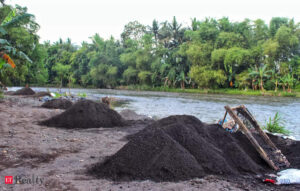India set to become world’s third-largest electricity consumer by 2050 as global demand for cooling soars, says IEA

New Delhi: Ushering in the ‘Age of Electricity’ to mark the shift in the world’s reliance to green energy, the International Energy Agency (IEA) has projected that India will become the third-highest consumer of electricity by 2050 as climate-related uncertainties lead to increased demand for cooling across the globe.
In itsWorld Energy Outlook 2024 released on Wednesday, the IEA said global electricity demand growth is set to accelerate in the years ahead, propelled by clean sources of power.
The report’s projections indicate that the world is set to enter a new energy market context in the coming years, marked by geopolitical hazards but also by relatively abundant supply of multiple fuels and technologies.
This includes an overhang of oil and liquefied natural gas supply coming into view during the second half of the 2020s, alongside a large surfeit of manufacturing capacity for key clean energy technologies, notably solar PV and batteries, the IEA said.
“We’ve witnessed the Age of Coal and the Age of Oil – and we’re now moving at speed into the Age of Electricity,” the agency said. This will define the global energy system going forward and increasingly be based on clean sources of electricity, it added.
India’s soaring electricity demand – estimated to grow at over 4% every year till 2050 – will exceed the average annual global demand growth during this period, the IEA estimated. From 2023 to 2050, average annual electricity demand growth across the globe is likely to accelerate to over 3% if all countries meet their national energy and climate targets, including net zero emission goals, the IEA said in the report.
“India becomes the third-largest electricity consumer in the world by 2050 on the back of growth in demand of over 4% a year,” the IEA said. Only China and the US will have higher demand than India by 2050.
Air-conditioning, appliances
Growth will be led by demand for air-conditioning in the country as more people will be able to afford it due to rising incomes, the IEA said, adding that the same pattern is likely to prevail in all emerging markets and developing economies (EMDEs). Electricity demand growth in EMDEs will be largely due to the affordability of home appliances as incomes rise as well as an increase in industrial activity, the IEA said.
“The combination of rising incomes and increasing global temperatures (will) generate more than 1 200 TWh (terawatt-hours) of extra global demand for cooling by 2035,” the IEA said, adding that this amount was greater than the entire Middle East’s electricity use today.
We’ve witnessed the Age of Coal and the Age of Oil – and we’re now moving at speed into the Age of Electricity.
The IEA estimated that demand for cooling buildings will rise 3.7% annually till 2035, and that 90% of this demand is likely to take place in EMDEs as a warming global climate boosts demand and leads to air-conditioners having to work harder to provide cooling.
“As well as raising overall demand, cooling is projected to lead to higher peaks in demand, putting additional strain on power grids,” the IEA said.
However, the IEA noted that the impact of home appliances in boosting electricity demand may lessen over the next decade as governments focus on developing green hydrogen to meet their net zero emission targets. India plans to meet its net zero emissions goal by 2070.
Cleaner renewable sources of energy such as solar photovoltaic cells and wind are likely to generate more electricity than before as dependence on coal for electricity generation weakens, the IEA said.
“Renewables, led by solar PV and wind, are set to play a much larger role in power systems over the next decade and beyond. By 2035, solar PV and wind (will) provide over 40% of electricity generation, a level that few countries have managed to date,” the IEA said.
Transition risk
The IEA also identified climate change as a risk to the global energy transition, indicating that unpredictable weather phenomena as well as prolonged heat waves may be a dampener to energy security policies worldwide.
“Energy security and climate action are inextricably linked: extreme weather events, intensified by decades of high emissions, are already posing profound energy security risks,” the IEA said.
Overall, the IEA forecasted continuity in the clean energy transition, adding that the reliance of nations on fossil fuels is likely to fall, thus cutting prices and creating opportunities for diversified investments in the sector.
“The breathing space from (fossil) fuel price pressures can provide policymakers with room to focus on stepping up investments in clean energy transitions and removing inefficient fossil fuel subsidies. This means government policies and consumer choices will have huge consequences for the future of the energy sector and for tackling climate change,” IEA executive director Fatih Birol said in a statement.
Catch all the Industry News, Banking News and Updates on Live Mint. Download The Mint News App to get Daily Market Updates.
MoreLess








